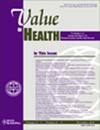The Influence of Recall and Timing of Assessment on the Estimation of Quality-Adjusted Life-Years When Health Fluctuates Recurrently
IF 4.9
2区 医学
Q1 ECONOMICS
引用次数: 0
Abstract
Objectives
When health fluctuates recurrently, estimating quality of life (QOL) is challenging, risking over-/underestimation due to measures’ recall periods and timing. To inform how/when to capture QOL, we compared responses using different recall periods and assessment timings.
Methods
For one 3-week chemotherapy cycle, cancer patients were randomly assigned to complete EQ-5D-5L or SF-12v2 (daily with a daily recall, weekly with a weekly recall, and at 3 weeks with a 3-week recall); a third group completed SF-12v2 daily with a 3-week recall. EQ-5D-5L and SF-6D utilities (anchored at 1 [full health] and 0 [dead]) were generated and repeated measures analysis of variance, t tests, and effect sizes were calculated to compare recall.
Results
A total of 503 patients consented; all 21 daily questionnaires were completed by 84 (50%), 67 (40%), and 72 (43%) in the groups. Both measures captured fluctuations in QOL suggesting differences are due to recall effects. Mean daily scores were greater than scores for the past week on days 7, 14, and 21 (P < .0001). Utility was underestimated (by 0.0782, 0.0374, and 0.0437) for EQ-5D-5L and (0.0387, 0.0266, and 0.0304) for SF-6D, with the EQ-5D-5L comparison on day 7 reaching a minimally important difference. The “past 3 weeks” generated the lowest scores (P < .0001), with utility underestimated by 0.0746 (EQ-5D-5L) and 0.0310 (SF-6D), heavily skewed by the first treatment week.
Conclusions
The current practice of using a single estimate at the beginning or end of a cycle with a daily (EQ-5D-5L) or longer (SF-12/SF-36) recall could bias cost-effectiveness estimates. QOL should be captured frequently with short recall when fluctuations are likely and less frequently with longer recall in stable periods.
健康反复波动时,召回和评估时间对质量aly估计的影响。
目的:当健康状况反复波动时,估计生活质量是具有挑战性的,由于测量的回忆期和时间,有被高估/低估的风险。为了了解如何/何时捕捉生活质量,我们比较了使用不同回忆期和评估时间的反应。方法:在一个为期3周的化疗周期中,癌症患者被随机分配完成EQ-5D-5L或SF-12v2(每日召回,每日召回,每周召回,3周召回,3周召回);第三组每天完成SF-12v2,为期3周的召回。生成EQ-5D-5L和SF-6D效用(锚定在1(全健康)和0(死亡)),并计算重复测量方差分析、t检验和效应量,以比较召回率。结果:503例患者同意;21份日常问卷分别由84人(50%)、67人(40%)、72人(43%)完成。两种测量方法都捕捉到了生活质量的波动,表明差异是由于回忆效应造成的。平均每日评分大于过去一周在第7天、第14天和第21天的评分(p结论:目前在一个周期的开始或结束时使用单一评估的做法,每日(EQ-5D-5L)或更长(SF-12/SF-36)召回可能会使成本-效果评估产生偏差。在可能出现波动的情况下,应经常用短期回忆法记录生活质量,而在稳定时期,则较少使用较长回忆法记录生活质量。
本文章由计算机程序翻译,如有差异,请以英文原文为准。
求助全文
约1分钟内获得全文
求助全文
来源期刊

Value in Health
医学-卫生保健
CiteScore
6.90
自引率
6.70%
发文量
3064
审稿时长
3-8 weeks
期刊介绍:
Value in Health contains original research articles for pharmacoeconomics, health economics, and outcomes research (clinical, economic, and patient-reported outcomes/preference-based research), as well as conceptual and health policy articles that provide valuable information for health care decision-makers as well as the research community. As the official journal of ISPOR, Value in Health provides a forum for researchers, as well as health care decision-makers to translate outcomes research into health care decisions.
 求助内容:
求助内容: 应助结果提醒方式:
应助结果提醒方式:


